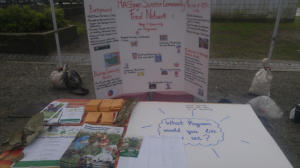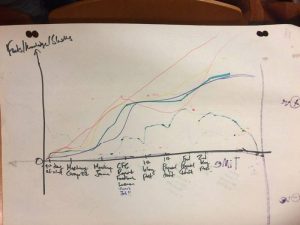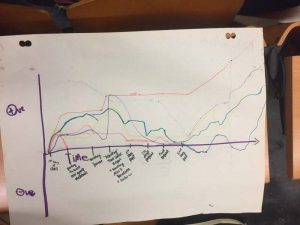Farewell
A moment of significance
What?
On Wednesday March 8th, Annie attended the focus group that was led by Benedetta and held at Hastings Community Centre. The purpose of this focus group was to ask the focus group questions that we have revised and to collect data from the participants. Benedetta was in charge of asking all the questions and Annie was responsible for taking notes. Five women who lived in the Hastings Sunrise community participated and surprisingly, all of them stated that they were not food insecure. One woman even asked what food insecurity meant and some of them were even donors for the Food Bank. This was a good experience for Annie who has attended because she did not attend the first focus group and had always wondered what a focus group looked like. She was surprised how outspoken and involved the participants were.
On Sunday March 12th, we ventured out East to the PNE so we could set up our own booth at the Vancouver Farmers Market in Hastings Sunrise. We created a poster board for our booth to share information about current and upcoming programs offered at the Hastings Sunrise Community Center. We created a interactive poster to gather ideas about programs the community would like to see as well as information about the on the ongoing focus groups that are occurring in the community. We developed a mailing list sign-up sheet to provide those who are interested with further information about programs and future focus groups, and lastly developed a space for conversation on the issues of food insecurity
.
So what?
Our goal of this focus group has not been fully met because the participants did not relate themselves to the questions, but we did gain some valuable insight based on their answers. Our group as well as Benedetta had hoped to learn more about people who are food insecure in the Hastings Sunrise Community. Nonetheless, this was a learning experience as we learned that people who are not food insecure tend to be more active in the community.
We had hoped to gather more information from the public however due to the weather conditions, it was a slower day for everyone at the market. We only had a few people sign up for more information and only one of them wished to participate in future focus groups. Though the results are small, they are still positive! Alex will take the emails we have provided her from the list and she can provide them with more information about upcoming programs and activities in the community.
Now what?
With our reflections and informations from the focus group and farmer’s market experiences, Annie and Julian met with Alex on March 22nd to discuss the next steps. In the end, we will not be organising the sixth focus group of the first stage of the Community Food Circles Project. The goal now for Alex and the Hastings-Sunrise Community Food Network is to implement programming by May. Another focus group may be held after a first round of programming to provide feedback that will be instrumental in the future development of this project in its future years.
One of the major challenges of this project was engaging community members that were actually facing issues of food insecurity, learning what programs are useful to them, and how we can strengthen the food security programing in the community. Going to farmers markets, and requesting for people to spend time to discuss their food insecurity issues might not be the most effective tools for community engagement. In one of our course readings, we learned about the linkages between housing and food security in Vancouver (Miewald, Ostry 2014). There are many connections between the infrastructure of the home, and food security. When there are inadequate cooking facilities in low income housing, this increases food insecurity for the tenants of those housing (Miewald, Ostry 2014). Maybe another tool for engagement that the Hastings Sunrise Community Food Network could utilize would be collaborating with the affordable housing initiatives in the community.
What we will be working on as a group is our implementable project using the insights we now have from our involvement with this project. What we know is that education of general skills in food literacy and preparation is the primary gap identified by the focus groups, and that programming will be focused on addressing this. Alex has suggested that we develop a plan for a program within the five main categories identified by the Community Food Circles Project (Budget friendly & sustainable cooking & food, Cooking & Nutrition for the Family, Cooking & Nutrition for Kids and Youth, Cooking & Nutrition for Seniors, Preserving & Canning). We hope that this program, and all others informed by the insights of the Community Food Circles, will empower the community and its people to apply new skills on a day-to-day basis, ensuring community food security in the home.
References:
Miewald, C., & Ostry, A. (2014). A Warm Meal and a Bed: Intersections of Housing and Food Security in Vancouver’s Downtown Eastside. Housing Studies, 29(6), 709–729.


